Seagate BarraCuda Pro 14TB HDD Review: Massive Storage for Desktops
by Ganesh T S on September 10, 2018 8:01 AM ESTPerformance - Internal Storage Mode
The performance of an internal storage device is dependent on the performance characteristics of the device as well as the file system being used. In order to isolate the effects of the latter, we first benchmarked the raw drives using HD Tune Pro 5.70. It was then formatted in NTFS and subject to our standard direct-attached benchmark suite.
Raw Drive Performance
HD Tune Pro allows us to run a variety of tests to determine transfer rates and IOPS for various artificial workloads. In addition, it also allows us to visualize how the performance varies as the tracking head moves from the outer parts of the platter towards the center (i.e, transfer rates as a function of the block address).
Empty drives are bound to perform very well, but, depending on the location of the data in the drive, we find that access rates can go as low as 117 MBps for sequential workloads (compared to the 112 MBps of the 12TB drive from last year). Write access times are a bit unpredictable due to the multi-segmented cache.
Random accesses are never the strong points of hard drives, and we see that the BarraCuda Pro delivers around 69 IOPS for 4K random reads and 222 IOPS for 4K random writes. The random read performance is very similar to the performance of the 12TB version from last year, while the random write performance receives a boost up from 191 IOPS.
The extra tests help in putting some numbers to sequential accesses targeting different areas of the drive. It also provides some interesting numbers relevant to various random access workloads.
DAS Benchmarks
Consumers opting for drives such as the 12TB Seagate BarraCuda Pro typically need high-capacity local storage for holding and editing / processing large-sized multimedia files. Prior to taking a look at the real-life benchmarks, we first check what CrystalDiskMark has to report for the drive. The numbers are in the same ballpark as the 12TB version from last year.
In order to tackle the real-life use-case of transferring large amounts of data back and forth from the drive, we created three test folders with the following characteristics:
- Photos: 15.6 GB collection of 4320 photos (RAW as well as JPEGs) in 61 sub-folders
- Videos: 16.1 GB collection of 244 videos (MP4 as well as MOVs) in 6 sub-folders
- BR: 10.7 GB Blu-ray folder structure of the IDT Benchmark Blu-ray (the same that we use in our robocopy tests for NAS systems)
| Seagate BarraCuda Pro 14TB robocopy Benchmarks (MBps) | ||
| Write Bandwidth | Read Bandwidth | |
| Photos | 197.81 | 206.81 |
| Videos | 219.51 | 206.99 |
| Blu-ray Folder | 222.00 | 212.36 |
These numbers are better than the ones we obtained for the 10TB version from 2016, but, fall a little short of the performance of the 12TB drive from last year.
While processing our DAS suite, we also recorded the instantaneous transfer rates and temperature of the drive. Compared to typical disk drives, the write transfers show higher instantaneous speeds due to a combination of the firmware and the 256 MB cache inside the drive. However, sustained write rates are comparable to other high-capacity drives when the cache is exhausted. The temperature of the unit at the end of the transfers (more than 250GB of traffic) rose by less than 4C, pointing to the power-efficiency of the platform.
For the use-case involving editing of multimedia files directly off the disk, we take advantage of PCMark 8's storage benchmark. The storage workload is a good example of a user workload, involving games as well as multimedia editing applications. The command line version allows us to cherry-pick storage traces to run on a target drive. We chose the following traces.
- Adobe Photoshop (Light)
- Adobe Photoshop (Heavy)
- Adobe After Effects
- Adobe Illustrator
Usually, PCMark 8 reports time to complete the trace, but the detailed log report has the read and write bandwidth figures which we present in our performance graphs. Note that the bandwidth number reported in the results don't involve idle time compression. Results might appear low, but that is part of the workload characteristic.
| Seagate BarraCuda Pro 14TB PCMark8 Storage Benchmarks (MBps) | ||
| Write Bandwidth | Read Bandwidth | |
| Adobe Photoshop (Light) | 248.16 | 9.01 |
| Adobe Photoshop (Heavy) | 233.95 | 11.03 |
| Adobe After Effects | 89.93 | 8.73 |
| Adobe Illustrator | 202.41 | 8.47 |
Compared to the results from the 12TB drive last year, we find that the read workloads fare very similarly, but, the write workloads have a slight edge.


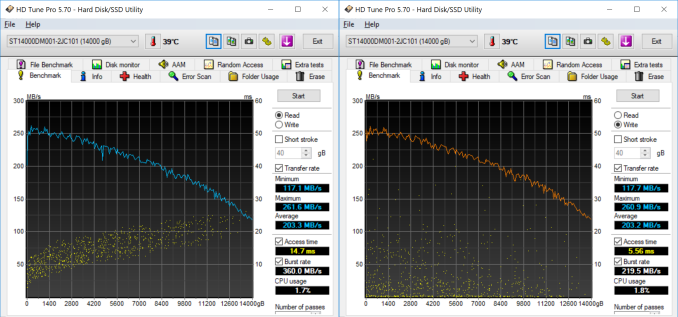
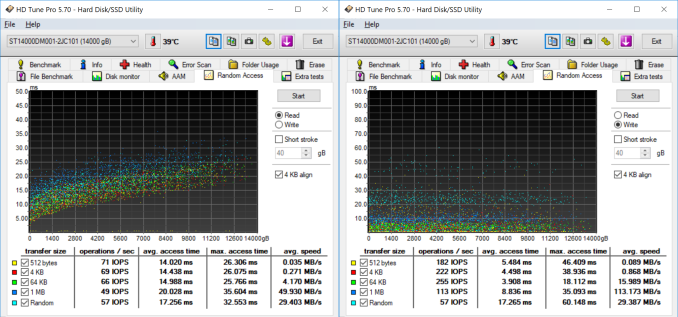
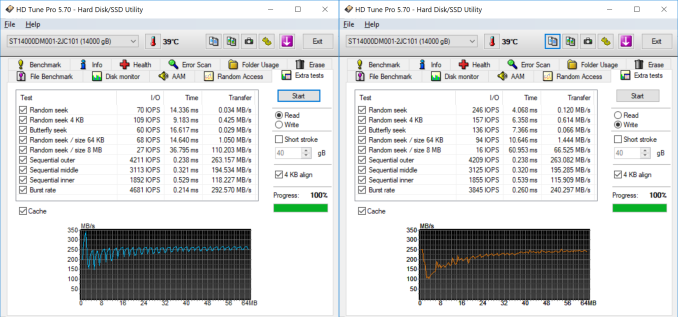
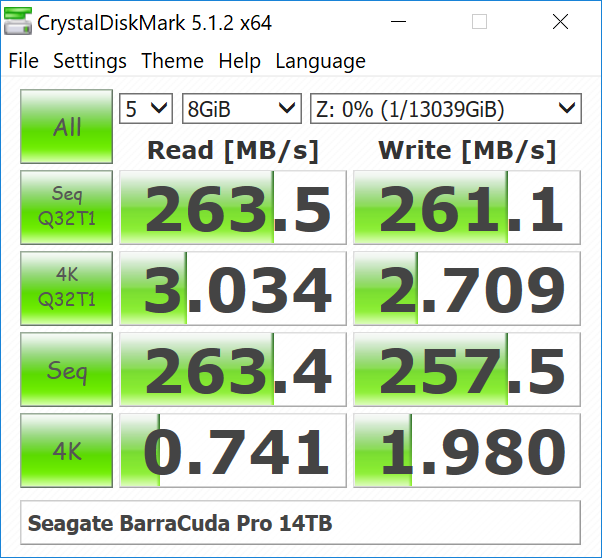
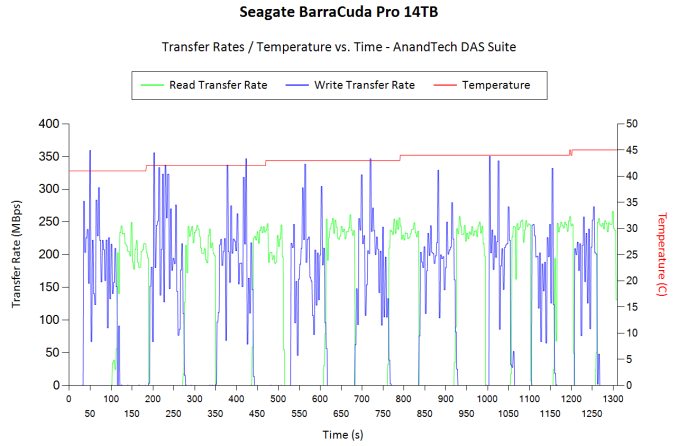








65 Comments
View All Comments
Ratman6161 - Monday, September 10, 2018 - link
Personally, I would not be using these in a RAID array. I would be using a RAID array of smaller disks that added up to a real world capacity similar to the single drive. With a RAID 5, you could tolerate a single drive failing without data loss.Byte - Monday, September 10, 2018 - link
Since it is a Seagate, that's a lot of data to lose.lorribot - Monday, September 10, 2018 - link
Most Enterprise storage vendors reommend RAID 6 for SATA drives due to their poor fault detecting abilities.What this can mean is when you have a disk in a RAID 5 fail and be replaced, during the 7 days it takes to rebuild your raid the extra load will either break another disk or you will suddenly find you have a undetected dead spot on a drive and your RAID will collapse. Still at least with the Disk recovery service you can get back your data, no wait you raided it so no chance.
Buy one disk and copy/backup to the cloud, no wait only have 0.5Mb/s up link on my fibre internet.......
Diji1 - Tuesday, September 11, 2018 - link
>In the desktop gaming market, per-game storage requirements are running into 100s of GBs, and SSDs continue to remain above $0.20/GB. Under these circumstances, high-capacity hard drives are continuing to remain relevant.I couldn't go back to hard drive storage for gaming.
DanNeely - Tuesday, September 11, 2018 - link
I'd hate to do so too, but not everyone can afford 1 or 2TB SSDs; and smaller sizes don't play nice with >100GB game installs. The flip side is that the semi-common gaming laptop spec of a 256/512GB SSD and 1TB HDD really needs an upgrade to the HDD too. That in turn needs the HDD makers to put out a 2TB 7200 RPM drive at something less than enterprise prices, and figure out how to cram 3TB into the 2.5" form factor in the reasonably near future.Ratman6161 - Tuesday, September 11, 2018 - link
Your wish has been granted. See:https://smile.amazon.com/dp/B01M0AADIX/ref=twister...
DanNeely - Tuesday, September 11, 2018 - link
It's not just that at 15mm they don't fit in laptops, those are 5400rpm drives not 7200. Spinning rust is bad enough under any circumstances, 5400 RPM is unacceptably worse for anything where IO performance matters at all.GTVic - Tuesday, September 11, 2018 - link
14TB, Otherwise known as 12.7TB...cjl - Tuesday, September 11, 2018 - link
14TB. Tera = 10^12, and this drive has 14*10^12 bytes.mapesdhs - Wednesday, September 12, 2018 - link
Yeah, that made me laugh when looking at the benchmark app info in the screenshots. :DGuess I'm old school, brought up with 2^n, but it is funny that the capacities are now so high, the real TB capacity (stuff this decimal nonsense) is more than an entire TB less than it first appears.